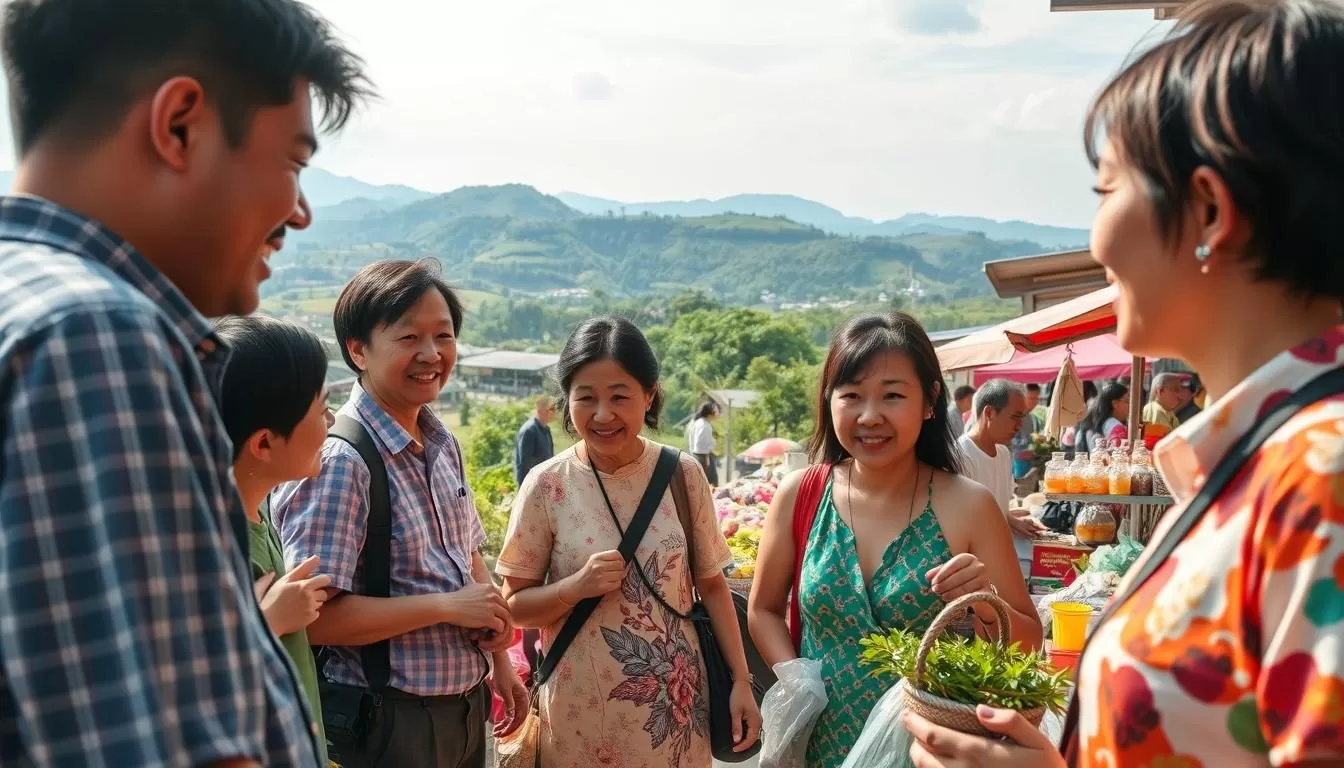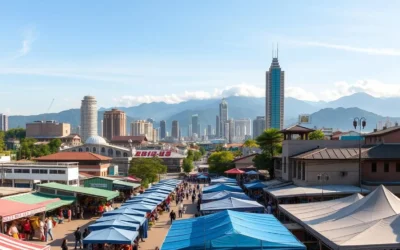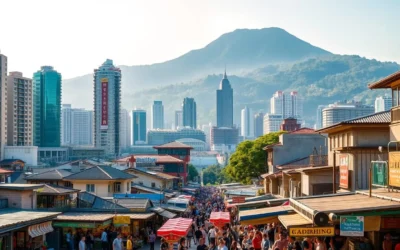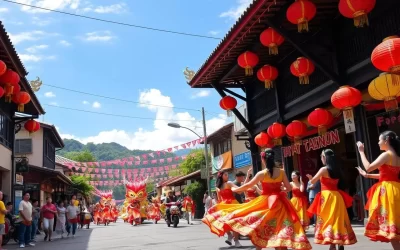✓ Accommodations✓ Flights✓ Rental Cars
As you explore Pingtung County, you’ll discover a rich tapestry of languages that reflect the region’s complex history and cultural diversity.
Located in southernmost Taiwan, this area boasts a unique blend of languages, including Mandarin Chinese, Taiwanese Hokkien, Hakka, and indigenous Formosan languages.
The population of Pingtung County is a vibrant mix of cultures, shaped by historical migrations and colonial influences. Understanding the language situation here helps you appreciate the county’s cultural heritage and connect with local residents.
This guide will walk you through the official and widely spoken languages in Pingtung, their development, current usage, and preservation efforts.
The Linguistic Landscape of Pingtung County
As you explore Pingtung County, you’ll discover a complex language environment influenced by its history and geography. Pingtung County’s unique position in southern Taiwan has made it a crossroads of cultures and languages throughout history.
Geographical and Cultural Context of Pingtung
Pingtung County’s proximity to the ocean has facilitated migrations from mainland China, particularly from the Fujian province, bringing Hokkien speakers to the region. The county’s geography has played a significant role in shaping its linguistic identity. The mountainous eastern areas have historically been home to indigenous people with their own distinct Formosan languages, adding another layer to the linguistic landscape.

Overview of Language Diversity in the Region
The language situation in Pingtung has been influenced by various waves of migration and colonial rule, including periods of Dutch, Japanese, and Chinese Nationalist control. Today, different languages coexist in Pingtung County, with usage patterns often correlating with factors such as age, education, urban/rural location, and ethnic background.
| Language Group | Speakers | Influencing Factors |
|---|---|---|
| Hokkien | Migrants from Fujian province | Migration, cultural exchange |
| Formosan Languages | Indigenous people | Historical presence, geographical isolation |
| Mandarin Chinese | Official and educational contexts | Government policies, education system |
Understanding the geographical and cultural context helps you appreciate why certain languages are spoken in specific areas of the county and how they’ve evolved over time, reflecting broader patterns across the island of Taiwan.
Mandarin Chinese: The Official Language
The official language of Pingtung County is Mandarin Chinese, which has become an integral part of the county’s linguistic landscape. As the primary language used in official contexts, Mandarin Chinese plays a crucial role in the daily lives of Pingtung County’s residents.
Status and Usage in Pingtung County
Mandarin Chinese became the official language of Taiwan, including Pingtung County, after 1945 when the Kuomintang (KMT) government took control following Japanese colonial rule. You’ll notice that Mandarin is used in all official contexts in Pingtung County, including government offices, schools, courts, and formal business settings. The prevalence of Mandarin in Pingtung County increased dramatically during the mid-20th century through government policies that promoted it as the national language while discouraging the use of other local languages. Today, virtually all residents of Pingtung County can speak Mandarin, though proficiency levels may vary among older generations who grew up speaking other languages at home.

Taiwanese Mandarin vs. Standard Mandarin
Taiwanese Mandarin, the variant spoken in Pingtung County, has some distinct characteristics that differentiate it from the Standard Mandarin spoken in Beijing, including differences in pronunciation, vocabulary, and certain grammatical patterns. You’ll find that Taiwanese Mandarin in Pingtung often incorporates loan words from Taiwanese Hokkien, Hakka, Japanese, and indigenous languages, reflecting the county’s multicultural heritage. Code-switching between Mandarin and other languages is common in daily conversations, with many residents adjusting their language use depending on the social context. The education system in Pingtung County uses Mandarin as the primary medium of instruction, ensuring its continued dominance among younger generations.
Understanding the nuances between Taiwanese Mandarin and Standard Mandarin can provide valuable insights into the linguistic diversity of Pingtung County. While Mandarin Chinese is the official language, its usage in Pingtung County is shaped by the local cultural and linguistic context.
Taiwanese Hokkien: The Local Tongue
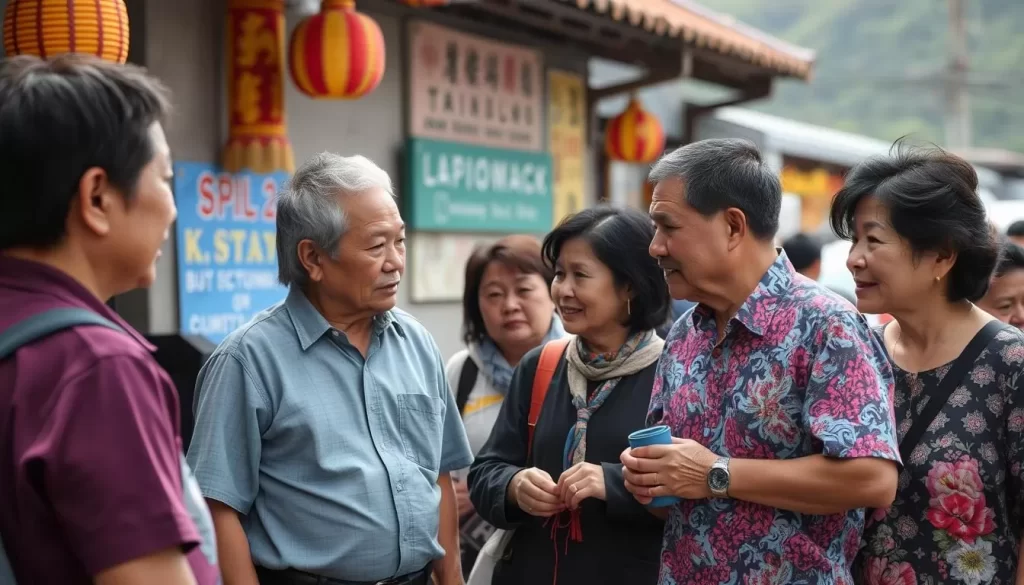
Taiwanese Hokkien is more than just a dialect; it’s a vital part of Pingtung County’s cultural identity. As you delve into the history and current usage of this language, you’ll understand its significance in the daily lives of the local population.
Historical Development in Pingtung
Taiwanese Hokkien has deep historical roots in Pingtung County, brought by immigrants from China’s Fujian province around 400 years ago. Over centuries, the language has evolved, influenced by geographical separation and contact with indigenous languages and later Japanese. This historical context has shaped the unique characteristics of Hokkien spoken in Pingtung.
The language has maintained its importance despite periods of suppression, and since the 1980s, it has experienced a revival. Today, it’s recognized as an important part of Taiwan’s cultural heritage.
Current Usage and Regional Variations
In Pingtung County, you’ll discover that Hokkien remains widely spoken, especially in rural areas, markets, and among older generations. Many residents are bilingual or multilingual, switching between Hokkien and Mandarin depending on the social context. The Hokkien spoken in Pingtung County serves as an important marker of local identity, with many cultural expressions preserved in this language.
Regional variations of Hokkien exist within the county, with subtle differences in pronunciation and vocabulary between coastal and inland communities. The language continues to evolve, incorporating new vocabulary while maintaining its distinctive grammatical structures and tonal patterns.
Hakka: A Significant Minority Language
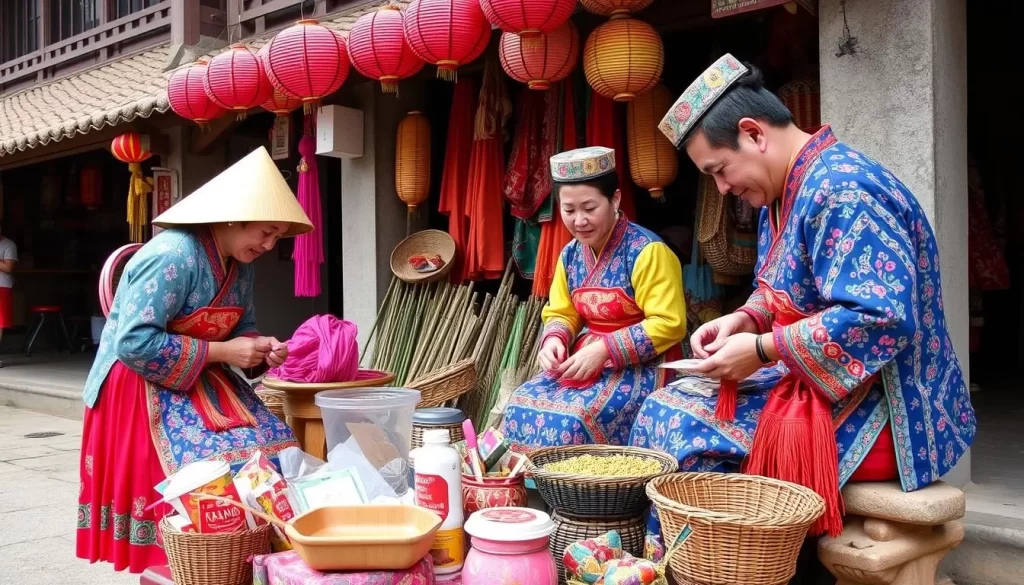
As you explore Pingtung County, you’ll discover the significant presence of Hakka people, a minority group that has maintained its linguistic and cultural heritage. The Hakka language is a vital part of this community’s identity, with a history that dates back to their migration from mainland China.
Hakka Communities in Pingtung County
The Hakka people have established communities primarily in the northern and central regions of Pingtung County. You’ll find that these communities have preserved their cultural traditions, including their language, despite being a minority population within the county. The Hakka community’s cultural practices, such as their architecture, cuisine, and festivals, are intricately linked to their language.
Subdialects and Preservation Efforts
The Hakka language in Pingtung County encompasses several subdialects, including Sixian, Hailu, and Dabu, reflecting the diverse origins of Hakka immigrants. To preserve the Hakka language, various initiatives have been implemented, including language classes in schools and community centers. The Hakka Affairs Council, established by the Taiwanese government, supports these efforts, promoting the language and culture among younger generations and the broader community.
You’ll notice that the Hakka community in Pingtung County is actively engaged in preserving its cultural heritage. With the support of local and national initiatives, the Hakka language and culture continue to thrive, contributing to the rich linguistic diversity of the region.
Indigenous Languages of Pingtung County
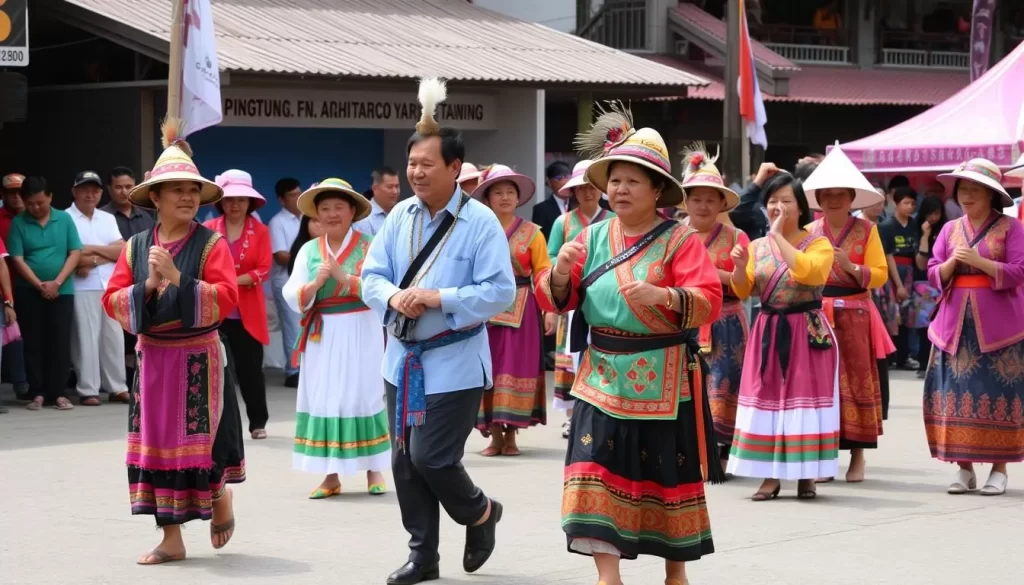
As you explore Pingtung County, you’ll discover the unique linguistic landscape formed by its indigenous communities. Pingtung County is home to significant indigenous populations, primarily from the Paiwan and Rukai tribes, who have inhabited the region for thousands of years before Chinese settlement.
Paiwan and Rukai Languages
The Paiwan and Rukai languages belong to the Austronesian language family and are part of the broader group of Formosan languages native to Taiwan. These indigenous languages have unique phonological systems, grammatical structures, and vocabularies that reflect the traditional lifestyles, belief systems, and ecological knowledge of their speakers.
The Paiwan language, for instance, is known for its complex system of pronouns and verb conjugations, while Rukai is recognized for its distinctive tonal system. Both languages are crucial elements of the cultural identity of their respective communities.
Preservation Challenges and Initiatives
Many indigenous languages in Pingtung County face serious threats to their survival, with declining numbers of fluent speakers as younger generations increasingly shift to Mandarin Chinese. The indigenous people of Pingtung are working to preserve their languages through various initiatives.
The Council of Indigenous Peoples has implemented various initiatives to document, preserve, and revitalize these languages, including standardized writing systems and educational materials. You’ll find that indigenous language education is now included in school curricula in indigenous areas of Pingtung, though the effectiveness of these programs varies. Cultural revitalization movements among indigenous groups in Pingtung have emphasized language as a crucial component of identity and traditional knowledge.
Modern technology is being leveraged to support language preservation, with digital dictionaries, language learning apps, and online resources becoming increasingly available for Paiwan and Rukai languages, offering new avenues for language learning and cultural preservation.
Pingtung County, Taiwan: Official and Widely Spoken Languages Today
You’ll find that Pingtung County’s linguistic profile is characterized by a blend of tradition and modernity, with various languages serving different social functions. The county’s language use reflects broader patterns across Taiwan, with a complex interplay between official and local languages.
Language Demographics and Statistics
The current language demographics in Pingtung County show that while Mandarin Chinese is universally understood, Taiwanese Hokkien remains the most commonly used language in daily life. According to recent surveys, approximately 81.9% of people in Taiwan speak Taiwanese Hokkien to some extent at home, with the percentage likely being higher in southern regions like Pingtung.
| Language | Speakers in Pingtung County | Percentage |
|---|---|---|
| Mandarin Chinese | Universally understood | Nearly 100% |
| Taiwanese Hokkien | Majority of the population | >80% |
| Hakka | Significant minority | Around 10-15% |
Multilingualism in Daily Life
Multilingualism is a common phenomenon among Pingtung residents, with many people comfortably switching between two or more languages depending on the social context, location, or conversation partner. The language situation varies by age group, with older generations more likely to use Taiwanese Hokkien or Hakka as their primary language, while younger people tend to be more comfortable in Mandarin.
You’ll observe that language choice in Pingtung often signals social relationships, with Mandarin used in formal settings while Hokkien or Hakka might be preferred among family members or close friends. Code-switching and language mixing are also common in everyday conversations, reflecting the multilingual competencies of many residents.
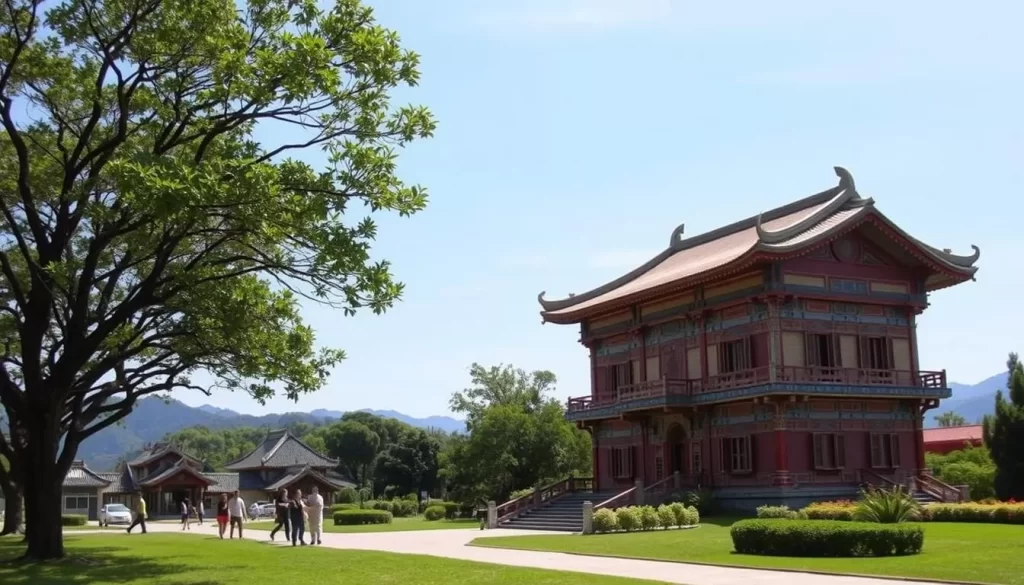
Public spaces in Pingtung County often feature multiple languages, with signage, announcements, and services available in various combinations of Mandarin, Taiwanese Hokkien, Hakka, and sometimes English. This multilingual environment is a testament to the county’s cultural diversity and the adaptability of its residents.
Written Languages and Scripts in Pingtung
When exploring Pingtung County, you’ll notice that the written languages and scripts are as diverse as the spoken ones, reflecting the county’s cultural heritage. The use of various writing systems is a testament to the county’s rich linguistic landscape.
Traditional Chinese Characters
Traditional Chinese characters are the standard writing system used in Pingtung County and throughout Taiwan, unlike mainland China which uses simplified characters. The Ministry of Education in Taiwan maintains the Standard Form of National Characters, which includes some minor variations from the character forms used in Hong Kong and Macau. You’ll find that written vernacular Chinese based on Mandarin grammar is the predominant form of written communication in Pingtung County, used in official documents, education, media, and everyday writing.
Romanization Systems and Indigenous Scripts
For writing Taiwanese Hokkien, a mixed system is often employed, combining traditional Chinese characters with romanized scripts such as Pe̍h-ōe-jī or the Taiwanese Romanization System. The romanization of Mandarin in Pingtung County has historically been inconsistent, with various systems including Wade-Giles, Tongyong Pinyin, and Hanyu Pinyin being used at different times. You’ll find that Zhuyin Fuhao (Bopomofo), a phonetic system consisting of 37 symbols, is widely used in Taiwan for teaching pronunciation of Chinese characters, especially in elementary education.
Indigenous languages in Pingtung County now have standardized writing systems based on the Latin alphabet, developed and maintained by the Council of Indigenous Peoples. These writing systems for indigenous languages are relatively recent developments, as these languages were primarily oral traditions without written forms until modern times.
Language Education in Pingtung County
As you explore the educational landscape of Pingtung County, you’ll discover a multifaceted approach to language education that reflects the region’s linguistic diversity.
School Language Policies
Mandarin Chinese is the primary medium of instruction in Pingtung County’s schools, in line with national education policies established in the mid-20th century. However, since the early 2000s, there has been a significant shift towards incorporating local languages into the curriculum.
This includes instruction in Taiwanese Hokkien, Hakka, or indigenous languages, depending on the school’s location and the community it serves. The Ministry of Education provides standardized textbooks and teaching materials for these local language classes, though the quality and effectiveness of implementation can vary across schools.
Language Learning Resources
Beyond the formal education system, Pingtung County offers a range of resources for language learners. Community centers, community colleges, and language clubs provide classes in Taiwanese Hokkien, Hakka, and indigenous languages, catering to diverse interests and age groups.
Digital resources have also expanded significantly, with numerous apps, websites, and online courses available for learners of various languages spoken in the county. Public libraries in Pingtung County typically maintain collections of materials in multiple languages, supporting both formal education and independent language learning.
| Language | Instruction Level | Resources Available |
|---|---|---|
| Mandarin Chinese | Primary to Higher Education | Textbooks, Online Courses |
| Taiwanese Hokkien | Primary to Adult Education | Local Language Classes, Community Centers |
| Hakka | Primary to Adult Education | Local Language Classes, Cultural Centers |
| Indigenous Languages | Primary to Adult Education | Local Language Classes, Community Colleges |
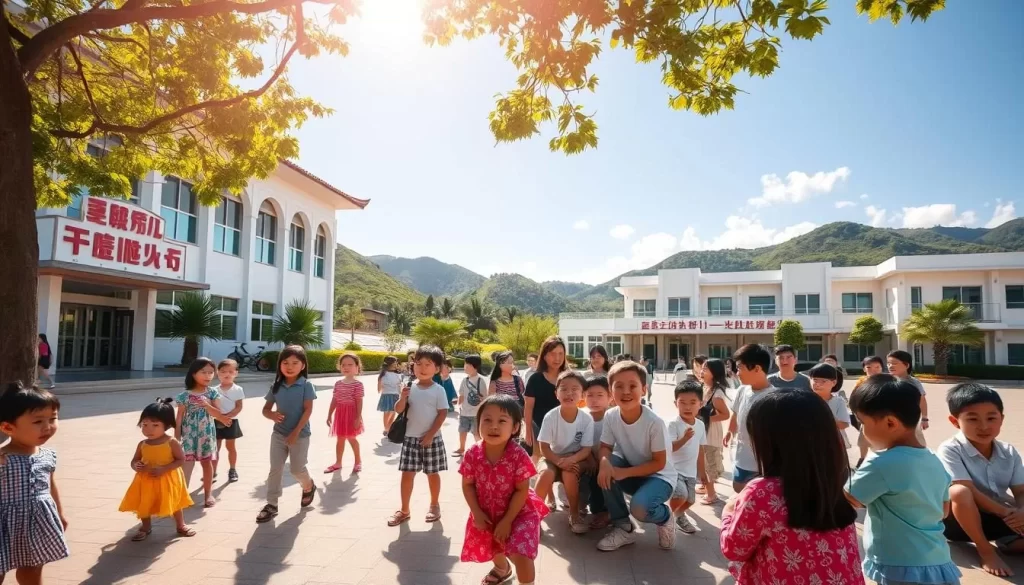
Language and Cultural Identity in Pingtung
As you explore Pingtung, you’ll discover that language plays a crucial role in shaping cultural identity. The county’s linguistic diversity is not just a reflection of its history and geography but also a key factor in understanding the local culture.
Language as a Marker of Identity
Language choice in Pingtung County often serves as a powerful marker of cultural identity. Many residents view their ability to speak Taiwanese Hokkien, Hakka, or an indigenous language as an important connection to their heritage. The political dimensions of language use in Pingtung reflect Taiwan’s complex history, with support for local languages often associated with Taiwanese nationalism.
Cultural expressions, including traditional performing arts, literature, and music, are often language-specific and serve as vehicles for preserving linguistic heritage. Younger generations in Pingtung are developing new relationships with traditional languages, sometimes embracing them as part of a conscious effort to reconnect with their cultural roots.
| Language | Cultural Significance | Preservation Efforts |
|---|---|---|
| Taiwanese Hokkien | Important for local identity | Language education programs |
| Hakka | Cultural heritage preservation | Community initiatives |
| Indigenous Languages | Essential for indigenous identity | Language documentation and revitalization programs |
Language Mixing and Code-Switching
Code-switching between languages is a common practice in Pingtung, with speakers often mixing Mandarin, Taiwanese Hokkien, and other languages within a single conversation or even a single sentence. This language mixing reflects both pragmatic communication strategies and expressions of hybrid cultural identities that characterize modern Taiwanese society.
Social media and popular culture in Pingtung often feature creative uses of multiple languages, creating new forms of expression that reflect the multilingual reality of contemporary life.
Language Challenges and Future Trends
As you explore the linguistic landscape of Pingtung County, you’ll encounter several challenges that threaten the survival of local languages. The region’s linguistic diversity is remarkable, with various languages coexisting, including Mandarin Chinese, Taiwanese Hokkien, Hakka, and indigenous Formosan languages.
Endangered Languages in the Region
Several languages in Pingtung County, particularly indigenous Formosan languages, face serious threats to their survival. The Paiwan and Rukai languages, while still spoken, have significantly fewer young speakers, categorizing them as endangered according to UNESCO criteria. Globalization and economic pressures have accelerated language shift, as proficiency in Taiwanese Mandarin and English is seen as essential for educational and career advancement.
You might notice that the decline of indigenous languages is not just a local issue but part of a broader trend. The influence of dominant languages can lead to a decrease in the use of local languages, especially among younger generations.
| Language | Status | Speakers |
|---|---|---|
| Paiwan | Endangered | Declining |
| Rukai | Endangered | Declining |
| Taiwanese Mandarin | Dominant | Increasing |
Government Initiatives and Policies
The government has implemented various policies over the years to address language endangerment. The Indigenous Languages Development Act and the National Languages Development Act provide legislative frameworks for language documentation, education, and revitalization efforts. You’ll discover that government initiatives include funding for language nests, master-apprentice programs, and community-based language revitalization projects in Pingtung County.
Digital technologies offer new opportunities for language preservation and revitalization. Online dictionaries, language learning apps, and social media create new domains for language use, potentially increasing the vitality of endangered languages.
Looking to the future, the balance between Taiwanese Mandarin and local languages in Pingtung will likely continue to evolve, influenced by educational policies, media representation, and changing attitudes toward linguistic diversity. Climate change and environmental challenges may also impact language vitality, particularly for indigenous communities whose traditional ecological knowledge is encoded in their languages.
Conclusion
As we conclude our exploration of Pingtung County’s linguistic landscape, it’s clear that the region’s language ecology is both rich and complex. You’ve seen how Mandarin Chinese serves as the official language and lingua franca, while Taiwanese Hokkien functions as the most widely spoken local language.
The historical development of languages in Taiwan reflects broader patterns of migration, colonization, and nation-building that have shaped the country’s linguistic diversity over centuries. In Pingtung County, this diversity is evident in the coexistence of Taiwanese Mandarin, Hakka, and indigenous Formosan languages.
Current language use in Pingtung County is characterized by multilingualism, code-switching, and evolving relationships between language and identity in a rapidly changing society. You’ve learned about the challenges facing minority languages, particularly indigenous Formosan languages, and the efforts being made to document, preserve, and revitalize these cultural resources.
The future of languages in Pingtung County will depend on a complex interplay of factors, including government policies, educational approaches, and community initiatives. Understanding the linguistic situation in Pingtung provides valuable insights into the county’s cultural heritage and social dynamics.
For visitors to Pingtung County, appreciating the Taiwanese Hokkien and other local languages can enhance the cultural experience and offer opportunities for more meaningful interactions with local communities. The story of languages in Pingtung County continues to unfold, with each generation adding new chapters to this fascinating narrative of linguistic and cultural evolution.
The above is subject to change.
Check back often to TRAVEL.COM for the latest travel tips and deals.
